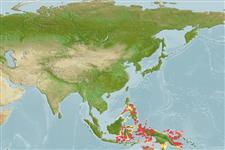>
Blenniiformes (Blennies) >
Blenniidae (Combtooth blennies) > Salariinae
Etymology: Cirripectes: Latin, cirrus = curl fringe + Greek, pektos, -e, -on = made of several parts solidly united (Ref. 45335); springeri: Named for Dr. Victor G. Springer..
Environment: milieu / climate zone / depth range / distribution range
Ökologie
seewasser riff-verbunden; tiefenbereich 0 - 18 m (Ref. 529), usually ? - 10 m (Ref. 529). Tropical; 15°N - 12°S
Western Pacific: Philippines; Moluccas, Indonesia; Bismarck Archipelago and Ninigo Islands, Papua New Guinea; Solomon Islands.
Length at first maturity / Size / Gewicht / Alter
Maturity: Lm ?, range 4 - ? cm
Max length : 10.0 cm TL Männchen/unbestimmt; (Ref. 48636)
Rückenflossenstacheln (insgesamt): 12 - 13; Rückenflossenweichstrahlen (insgesamt): 14-16; Afterflossenstacheln 2; Afterflossenweichstrahlen: 15 - 17; Wirbelzahl: 30 - 31. Diagnosis: Dorsal fin XII, 15, membrane attached to caudal fin, with deep notch above last spine, first spine up to almost thrice the height of second spine in males, but in females less than twice only; anal fin II, 16; pectoral rays 15; pelvic fin I, 4; caudal fin procurrent rays 10-12. Vertebrae 10 + 21. LL, without scales and scalelike flaps; LL tubes 0-5, canal ends below dorsal ray 2-8. Lower lip smooth mesially, plicate laterally. Upper lip crenulae 36-47. Gill rakers 23-30. Cephalic sensory pore system simple, midsnout pores absent. Cirri, supraorbital 2-9, nasal 5-23; nuchal 27-38, in 4 groups, ventralmost borne on a small nuchal flap. Overall dark brown with orange spots in juveniles, subadults and adults; dorsal fin rays and caudal fin upper rays, tips red-orange; iris red (Ref. 529).
Facultative air-breathing in the genus (Ref. 126274); Adults inhabit upper edge of outer reef slopes (Ref. 90102), 0-18 m deep (Ref. 529). Found in shallow and protected inshore reefs with sparse coral and rich algae growth (Ref. 48636). Also found in coral reef crevices. They feed on algae and detritus. Usually occur in small loose groups but are shy species and are easily missed by divers that are not on the look-out for blennies (Ref. 48636). Collected from water shallower than 10 m to as great as 18 m in the Ninigo Islands. Oviparous. Eggs are demersal and adhesive (Ref. 205), and are attached to the substrate via a filamentous, adhesive pad or pedestal (Ref. 94114). Larvae are planktonic, often found in shallow, coastal waters (Ref. 94114).
Oviparous, distinct pairing (Ref. 205). Urogenital orifice of male genital papilla located basally between 2 widely separated slender filaments on a fleshy swelling behind anus; testes bulbous with length equal its width (Ref 529).
Williams, J.T., 1988. Revision and phylogenetic relationships of the blenniid fish genus Cirripectes. Indo-Pac. Fish. (17):78 p. (Ref. 529)
IUCN Rote Liste Status (Ref. 130435)
Bedrohung für Menschen
Harmless
Nutzung durch Menschen
Fischereien: nicht kommerziell
Mehr Information
ReferenzenAquakulturAquakultur ProfilZuchtlinienGenetikElectrophoresesVererbbarkeitKrankheitenVerarbeitungNutrientsMass conversion
PartnerBilderStamps, Coins Misc.LauteCiguateraGeschwindigkeitSchwimmstilKiemenoberflächeOtolithsGehirngrößeSehfähigkeit
Tools
Zusatzinformationen
Download XML
Internet Quellen
Estimates based on models
Preferred temperature (Ref.
123201): 28.4 - 29.3, mean 28.9 °C (based on 672 cells).
Phylogenetic diversity index (Ref.
82804): PD
50 = 0.5000 [Uniqueness, from 0.5 = low to 2.0 = high].
Bayesian length-weight: a=0.01072 (0.00480 - 0.02393), b=3.01 (2.82 - 3.20), in cm total length, based on LWR estimates for this (Sub)family-body shape (Ref.
93245).
Trophic level (Ref.
69278): 2.0 ±0.00 se; based on food items.
Widerstandsfähigkeit (Ref.
120179): hoch, Verdopplung der Population dauert weniger als 15 Monate. (Preliminary K or Fecundity.).
Fishing Vulnerability (Ref.
59153): Low vulnerability (10 of 100).
Nutrients (Ref.
124155): Calcium = 137 [73, 235] mg/100g; Iron = 0.918 [0.551, 1.493] mg/100g; Protein = 18.3 [17.2, 19.4] %; Omega3 = 0.132 [0.080, 0.218] g/100g; Selenium = 22.3 [12.5, 42.9] μg/100g; VitaminA = 113 [33, 393] μg/100g; Zinc = 2.54 [1.73, 3.61] mg/100g (wet weight);
